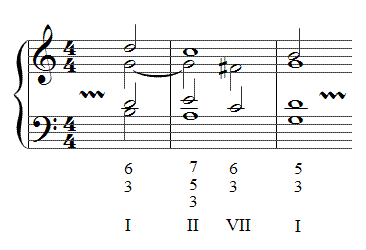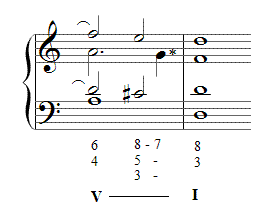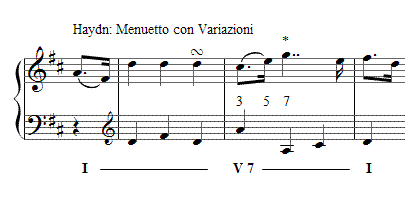APPENDIX A: VOICE LEADING OVERVIEW
The Emancipated Dominant 7th Chord
The unprepared dominant 7th chord is a second important example of the unprepared discord, which became common after the strict counterpoint of the 16th century. In the 16th century, seventh chords were only possible in 3 or more parts where the dissonant 7th was prepared and resolved according to the principles descried in previous sections. i.e. the 7th has to be treated as a passing note or as a suspension. The following example of the full 7th chord on the second degree of the scale is common in Palestrina:

The second chord contains the minor 3rd, perfect 5th and minor 7th but the 7th is prepared and resolved as indicated in the section Syncopation. This is not a dominant 7th, of course, as the third is minor. This is what we would call a supertonic 7th chord in tonal music. In Palestrina's time, this was not thought of in such terms. Roman numeral, Functional Harmony and its terminology came much later. In 16th century music, the harmony is considered to result only from the horizontal voice leading.
The cadence is completed by what is, in effect, chord VII to chord I. Palestrina did not use the full dominant 7th chord, the closest he came to using the dominant 7th chord is as follows:

In this example, the 7th (marked *) is a passing note between the 8 of chord V and the 3rd of the tonic chord. Palestrina used many other cadential patterns, but does not use the full dominant 7th chord, prepared or unprepared. The V7 - I cadence is unheard of in this period. This is not too much of a restriction in a period where voice leading is all important. Palestrina and other composers of the period were more concerned about the way the voices approached the cadence and less about the vertical form of the chords that were created. Note the 6 and 4 from the bass would have to be prepared as suspensions, in this period.
In later music, in particular baroque and classical music, root progression patterns come into their own and more importance was given to harmonic progressions. This necessitated a relaxation in the rules of voice leading in order to facilitate a variety of new chord progressions. The most important of these is the relaxation of the rule about the preparation of the 7th for the dominant chord. The following example from Haydn involves the full dominant 7th chord (arpeggiated - shown as 3, 5, 7).

Here the 7th of the dominant chord (G of the A7 chord, marked *) is introduced without any preparation. This apparently small change in voice leading enabled new harmonic patterns that had not been possible earlier. Most important of these is the new static harmony pattern:
I - V7 - I
Previously, it was not possible to introduce V7 after chord I as chord I does not contain the note required to prepare the dissonant 7th. In this example, the tonic chord (D) does not contain the note G which would be needed to prepare the G discord. This progression was totally new and daring when first introduced in the 17th century. It spawned unlimited numbers of new melodies that had not previously been possible.
The dominant 7th chord was also very important in the new harmony because it contained enough notes to unequivocally define the key. This was important, during this period, because of the emergence of modulation (see Chapter 7). The arrival of a new key could be suggested by the introduction of a new dominant 7th chord.
This appears, at first sight, to be just a small change in the rules of voice leading. But this would, at the time, have sounded very daring and novel. In reality, it was nothing less than a revolution in chord syntax and voice leading and an unlimited number of new melodies became possible using this new sounding progression. This change gave birth to well known melodies such as:

In this example, the sevenths are unprepared and as in the previous example, the chords are arpeggiated and the melody line is doubled in bass and treble. However, the chord progression is clear.
Next Topic: Chromaticism - Background

